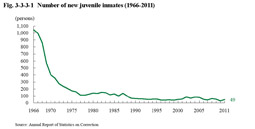Section 3 Juvenile Inmates
Fig. 3-3-3-1 shows the number of new juvenile inmates (refers to juveniles sentenced to imprisonment with or without work and imprisoned to serve their sentences at penal institutions) since 1966. The number exceeded 1,000 in 1966, but then decreased significantly and remained below 100 from 1988, and was 49 in 2011 (up 20 from the previous year). Only one of the new juvenile inmates in 2011 was a female. By age at the time of admission (age at the time they received an indeterminate sentence of those 20 or older when admitted), one was 16-17, and 48 were 18-19. Examining the number of new juvenile inmates by their term of sentence (maximum term with indeterminate sentences) revealed that none of them was sentenced to life imprisonment, 26 to “over 5 years but 10 years or less,” 15 to “over 3 years but 5 years or less,” and eight to 3 years or less. By type of punishment, 47 were sentenced to imprisonment with work and two to imprisonment without work. By type of offense, injury at 12 (injury at two, injury causing death 10) was the largest in number, followed by robbery at nine (robbery causing death or injury at seven, rape at the scene of a robbery/rape at the scene of a robbery causing death at two), rape/rape causing death or injury at six, homicide at five, negligence in vehicle driving causing death or injury at four, theft at four, and fraud at three (Source: Annual Report of Statistics on Correction).
Fig. 3-3-3-1 Number of new juvenile inmates (1966-2011)
Juvenile inmates are considered to be still physically/mentally developing and thus also still sufficiently adaptable, and are therefore treated according to these characteristics at penal institutions. The treatment guidelines for juvenile inmates (See (1) of Subsection 1, Section 2, Chapter 4, Part 2) are formulated with goals at the finely divided stages of introduction, development, and generalization. They are given an advantage of concentrating on academic education, with possible opportunities to take vocational training as well, and useful work when they engage in work in the course of correctional treatment.
In addition, at least one official is assigned to each juvenile inmate (individual assignment system), who then closely cooperate with the other officials and implement consistent individual guidance, including individual counseling and guidance on writing a diary.
If the juveniles are serving their sentences in juvenile training schools, they are not subject to work and instead receive correctional education.
